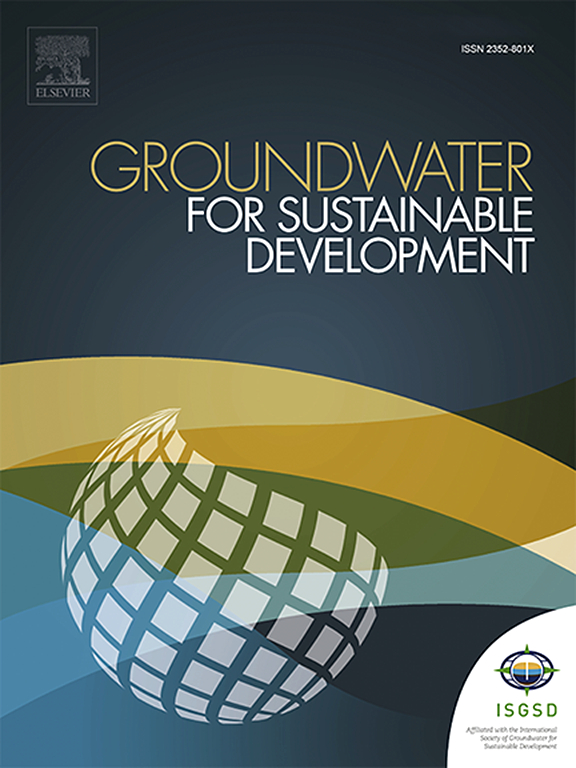Impacts of agricultural intensification on the hydrologic components for a coastal river basin using coupled hydrological model
IF 4.9
Q2 ENGINEERING, ENVIRONMENTAL
引用次数: 0
Abstract
Understanding the impacts of the changes in land use and cover (LULC) on the hydrological components was a prime factor for water resource management (SDG 6). Among the different LULC change patterns, agricultural intensification has recently been identified in various parts of the globe. The present study aims to understand the impacts of intensification of agricultural land use (Sankarrao et al.,2021) on the hydrological components within the Nagavali River Basin (NRB) catchment, India. In this context, the fully distributed hydrodynamic MIKESHE model was calibrated well from 2004 to 2014, with an NSE of 0.76 and 0.86 on daily and monthly time scales, respectively. Three scenarios were developed, namely baseline, past, and future scenarios, using three LULC maps of 1990, 2010, and 2030 to evaluate the impact of the intensification of agricultural land use on the hydrological components. The intensification of agricultural land use is due to the reduction in scrubland land use and forest land use (SDG 15) between 1990 to 2010 and 2010 to 2030, respectively. The annual average values of surface runoff, baseflow, and groundwater recharge were increased by 48.45 mm, 2.55 mm, and 22.45 mm, respectively, over the two comparison periods. On the other hand, a reduction of 59.55 mm was observed in the annual average AET at 59.55 mm/year. The Pearson correlation was used to identify the attribution of different LULC changes with hydrological components. The changes in agricultural land use positively correlate with changes in surface runoff, baseflow, and groundwater recharge, whereas actual evapotranspiration has a negative correlation. The spatial distribution of these hydrological component changes was identified at the sub-basin level. Overall, the results explained that the intensification of agricultural land use has increased surface runoff and groundwater recharge within the basin.

基于耦合水文模型的沿海河流流域农业集约化对水文成分的影响
了解土地利用与覆盖(LULC)变化对水文成分的影响是水资源管理的主要因素(可持续发展目标6)。在不同的土地利用与覆盖变化模式中,最近在全球不同地区发现了农业集约化。本研究旨在了解农业土地利用集约化对印度纳加瓦利河流域(NRB)集水区水文成分的影响(Sankarrao等,2021)。在此背景下,2004 - 2014年全分布水动力MIKESHE模型的校准效果良好,日和月时间尺度的NSE分别为0.76和0.86。利用1990年、2010年和2030年的三幅LULC地图,开发了基线、过去和未来三种情景,以评估农业用地集约化对水文成分的影响。农业用地集约化是由于在1990 - 2010年和2010 - 2030年期间,灌木林和林地的利用分别减少(可持续发展目标15)。地表径流、基流和地下水补给的年平均值在两个比较期内分别增加了48.45 mm、2.55 mm和22.45 mm。年平均AET为59.55 mm/年,减少59.55 mm。使用Pearson相关来确定不同的LULC变化与水文成分的归因。农地利用变化与地表径流、基流和地下水补给呈正相关,而实际蒸散量呈负相关。在次流域水平上确定了这些水文成分变化的空间分布。总体而言,研究结果解释了农业用地的集约化增加了流域内的地表径流和地下水补给。
本文章由计算机程序翻译,如有差异,请以英文原文为准。
求助全文
约1分钟内获得全文
求助全文
来源期刊

Groundwater for Sustainable Development
Social Sciences-Geography, Planning and Development
CiteScore
11.50
自引率
10.20%
发文量
152
期刊介绍:
Groundwater for Sustainable Development is directed to different stakeholders and professionals, including government and non-governmental organizations, international funding agencies, universities, public water institutions, public health and other public/private sector professionals, and other relevant institutions. It is aimed at professionals, academics and students in the fields of disciplines such as: groundwater and its connection to surface hydrology and environment, soil sciences, engineering, ecology, microbiology, atmospheric sciences, analytical chemistry, hydro-engineering, water technology, environmental ethics, economics, public health, policy, as well as social sciences, legal disciplines, or any other area connected with water issues. The objectives of this journal are to facilitate: • The improvement of effective and sustainable management of water resources across the globe. • The improvement of human access to groundwater resources in adequate quantity and good quality. • The meeting of the increasing demand for drinking and irrigation water needed for food security to contribute to a social and economically sound human development. • The creation of a global inter- and multidisciplinary platform and forum to improve our understanding of groundwater resources and to advocate their effective and sustainable management and protection against contamination. • Interdisciplinary information exchange and to stimulate scientific research in the fields of groundwater related sciences and social and health sciences required to achieve the United Nations Millennium Development Goals for sustainable development.
 求助内容:
求助内容: 应助结果提醒方式:
应助结果提醒方式:


